Envelope Feeder Attachment
This section describes how to use the optional Envelope Feeder Attachment-D1. The envelope feeder attachment can only be attached to Paper Drawer 2. (Envelope Feeder Attachment-D1)
The envelope feeder attachment can hold the following types of envelopes: No.10 (COM10), ISO-B5, Monarch, ISO-C5, and DL. (Available Paper Stock)
|
IMPORTANT
|
|
When you attach the envelope feeder attachment to the paper drawer, do not forcefully move the front and side guides of the paper drawer in the wrong direction. Doing so may damage the paper drawer.
Do not print on both sides of an envelope. Doing so may cause paper jams or dirty prints, or make the inside of the machine dirty.
Correctly define the Envelope Cassette settings to match the size of the envelopes being loaded. Failure to do so may cause paper jams or dirty prints, or make the inside of the machine dirty.
Do not load the following types of envelopes in the envelope cassette, as they may cause paper jams or dirty prints, or make the inside of the machine dirty:
Curled, creased, or folded envelopes
Very thick or thin envelopes
Damp or wet envelopes
Torn envelopes
Irregularly shaped envelopes
Envelopes with clasps or windows
Envelopes that have already been sealed
Envelopes with holes or perforations
Envelopes with specially coated surfaces
Envelopes made of surface-treated colored paper
Envelopes that are self-sticking, which use ink, glue, or other substances that can melt, burn, vaporize, or emit smells under the heat of the fixing unit (approximately 200°C). (Depending on the materials used for the seal, the glue may melt under the fixing unit's heat, sealing the envelopes.)
If you want to adjust the width guides to load ISO-C5 or ISO-B5 envelopes, contact your local authorized Canon dealer.
|
|
NOTE
|
|
When printing on envelopes, empty the output tray once 10 envelopes have accumulated in the tray.
Envelopes should be stored in a place away from heat and humidity.
If there is a temperature difference between the location where the envelopes were stored and the location where the envelopes are being printed, leave the envelopes in the printing location at room temperature before you use them.
|
Preparing Envelopes
Before loading envelopes in the paper drawer, prepare the envelopes as described below.
1
Take five envelopes, loosen them as shown, and then stack them together. Repeat this step five times for each set of five envelopes.
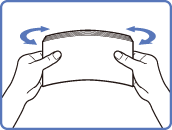
2
Place the envelopes on a clean, level surface and press all the way around the envelopes in the direction of the arrows to remove any curls. Repeat this step five times for each set of five envelopes.
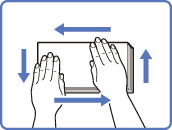
Take particular care to spread the envelopes out in the direction that they will be fed.
3
Hold down the top edge of the envelopes firmly, so that the flaps stay flat.
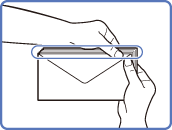
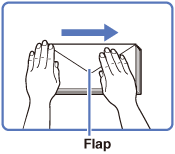
|
NOTE
|
|
If the envelopes become filled with air, flatten them by hand before loading them in the paper drawer.
If you feed envelopes that have glue attached to their flaps, the glue may melt due to the heat and pressure of the fixing unit.
|
Loading Envelopes
After preparing your envelopes, load them in Paper Drawer 2 as described below.
1
Press the button on Paper Drawer 2.
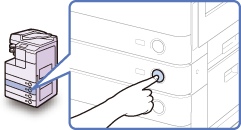
2
Grip the handle and pull out the paper drawer until it stops.
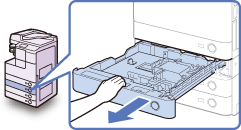
3
Load 10 envelopes at a time with the side you want to print on face up. While loading the envelopes, press down on the right side of the receptacle to lock them into place.
Make sure that the height of the envelope stack does not fall below the height limit mark ( ).
).
 ).
).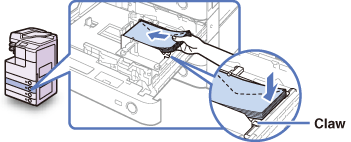
Make sure that the flaps are positioned as shown below.
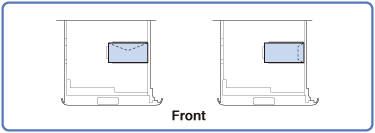
Align the leading edges of the envelopes, and make sure that they are held in place under the claw.
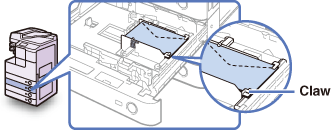
|
IMPORTANT
|
|
Rolled or curled envelopes must be straightened out prior to use.
The maximum height (quantity) of envelopes that can be loaded into the cassette is approximately 30 mm. As a reference, 30 mm is approximately 50 envelopes. (This number may vary depending on the envelope type and user operating conditions.)
|
4
Gently push the paper drawer back into the machine until it clicks into place.
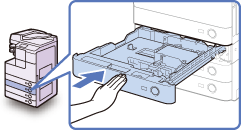
 |
|
When returning the paper drawer to its original position, be careful not to get your fingers caught, as this may result in personal injury.
|
|
IMPORTANT
|
|
Do not place paper or any other items in the empty part of the paper drawer next to the envelopes. Doing so may cause paper jams.
|
|
NOTE
|
|
An insufficient number of envelopes may cause the machine to stop feeding envelopes. If this happens, load more envelopes.
|
Loading a Different Type of Envelopes
If you want to load different types of envelopes in Paper Drawer 2, adjust the envelope feeder attachment as described below.
1
Select the Envelope Cassette settings for the new envelope type.
For help, see Identifying the Type of Envelope in Paper Drawer 2.
|
IMPORTANT
|
|
Correctly define the Envelope Cassette settings to match the size of the envelopes being loaded. Failure to do so may cause paper jams or dirty prints, or make the inside of the machine dirty.
|
2
Open Paper Drawer 2.
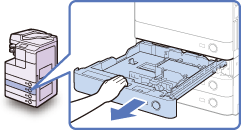
For help, see steps 1 and 2 in Loading Envelopes.
3
Grasp the left and right sides of the paper drawer to pull and lift it out of the machine.
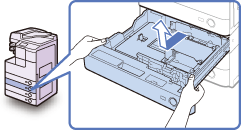
4
Remove all the loaded envelopes.
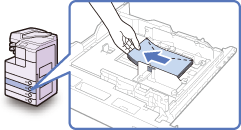
5
Squeeze the lever on the side guide. Without releasing the lever, slide the side guide leftward or rightward to align it with the mark for the desired envelope size.

6
Unscrew the front width guide of the envelope feeder attachment.
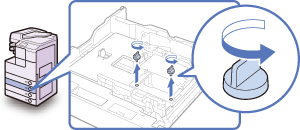
7
While holding down the envelope receptacle, move the front width guide to align it with the mark for the desired envelope size.
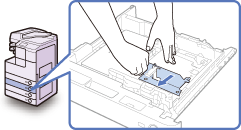
8
Screw the front width guide to fix it.
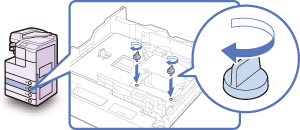
9
Move the back width guide of the envelope feeder attachment in the same manner as the front width guide.
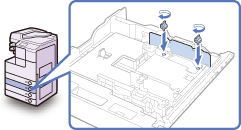
For help, see steps 6 to 8.
10
Load 10 envelopes at a time with the side you want to print on face up. While loading the envelopes, press down on the right side of the receptacle to lock them into place.
Make sure that the height of the envelope stack does not fall below the height limit mark ( ).
).
 ).
).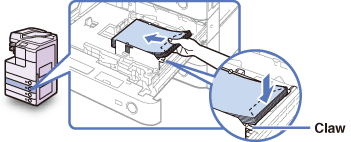
Make sure that the flaps are positioned as shown below.

Align the leading edges of the envelopes, and make sure that they are held in place under the claw.
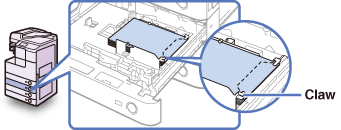
|
IMPORTANT
|
|
Rolled or curled envelopes must be straightened out prior to use.
The maximum height (quantity) of envelopes that can be loaded into the cassette is approximately 30 mm. As a reference, 30 mm is approximately 50 envelopes. (This number may vary depending on the envelope type and user operating conditions.)
|
11
Use the size switch to select the preset envelope type.
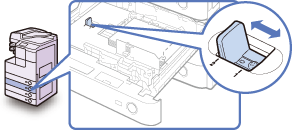
If the type of the loaded envelopes has been set for [ENV.1]:
|
1
|
Slide the size switch to the ‘1’ side.
|
If the type of the loaded envelopes has been set for [ENV.2]:
|
1
|
Slide the size switch to the ‘2’ side.
|
|
IMPORTANT
|
|
Correctly define the Envelope Cassette settings to match the size of the envelopes being loaded. Failure to do so may cause paper jams or dirty prints, or make the inside of the machine dirty.
|
12
Change the paper size label to indicate the correct envelope type on the paper drawer.
For help, see step 5 in Adjusting a Paper Drawer to Hold a Different Paper Size.
13
Gently push the paper drawer back into the machine until it clicks into place.
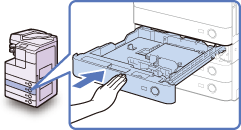
 |
|
When returning the paper drawer to its original position, be careful not to get your fingers caught, as this may result in personal injury.
|
|
IMPORTANT
|
|
Do not place paper or any other items in the empty part of the paper drawer next to the envelopes. Doing so may cause paper jams.
|
|
NOTE
|
|
An insufficient number of envelopes may cause the machine to stop feeding envelopes. If this happens, load more envelopes.
|